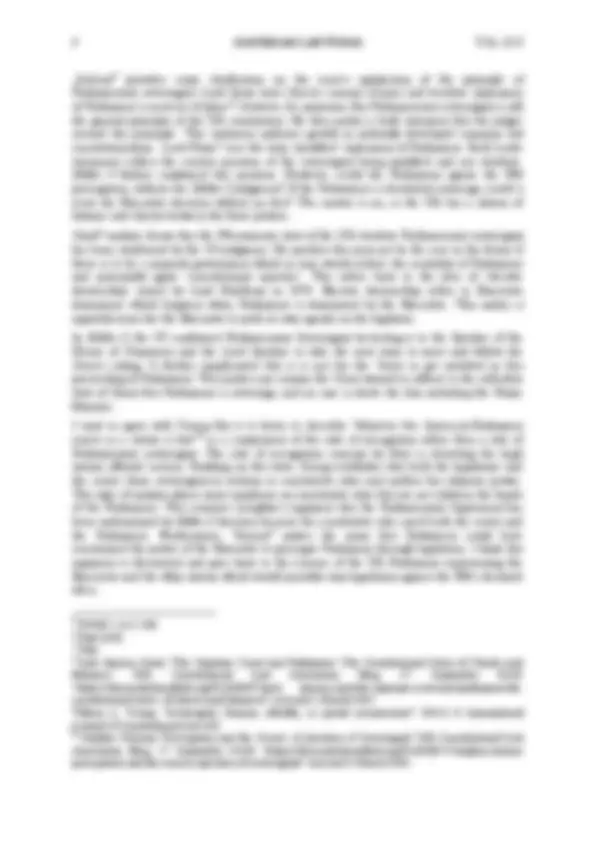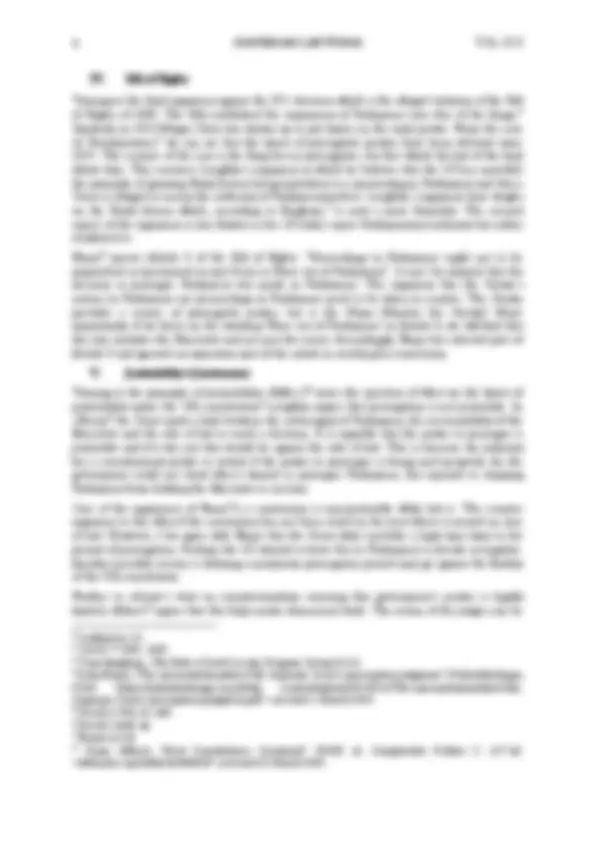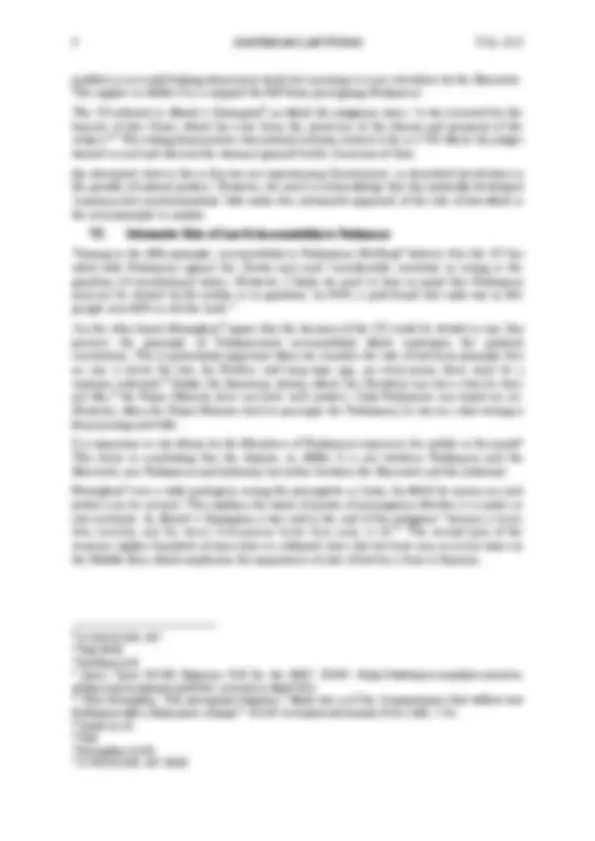





Study with the several resources on Docsity

Earn points by helping other students or get them with a premium plan


Prepare for your exams
Study with the several resources on Docsity

Earn points to download
Earn points by helping other students or get them with a premium plan
Community
Ask the community for help and clear up your study doubts
Discover the best universities in your country according to Docsity users
Free resources
Download our free guides on studying techniques, anxiety management strategies, and thesis advice from Docsity tutors
I will cover five relevant constitutional principles that support Elliot's view: separation of powers, Parliamentary sovereignty, Bill of Rights ...
Typology: Study notes
1 / 6

This page cannot be seen from the preview
Don't miss anything!




Commentary MILLER 2: A POLITICAL DECISION OR A SAVIOUR OF THE UK CONSTITUION?
I. Introduction
However, the impact of the judgment on the UK constitutional principles of relative separation of powers and judicial activism is arguably far reaching has led scholars to debate at length the Supreme Court’s decision. On the one hand, Loughlin^2 views the decision as politically motivated, while on the other, Elliot 3 views the decision as upholding the basic constitutional principles. I agree with Elliot that the Supreme Court’s decision is in line with the basic principles of the UK uncodified constitution. I will cover five relevant constitutional principles that support Elliot’s view: separation of powers, Parliamentary sovereignty, Bill of Rights, justiciability and rule of law. Before concluding, I shall highlight areas where the SC decision could have been drafted better for both Whitehall and Westminster. II. Separation of Powers The Supreme Court did not shy away from discussing 4 the constitutional principle of the separation of powers, stating: “Under the separation of powers, it is the functions of the courts to determine them.” This establishes the judiciary authority in defining the separation of powers. The SC had set a specific two step test 5
prorogation is unlawful if it is without reasonable justification which frustrates Parliament’s ability to carry out its constitutional functions. If we break the test into two parts, the frustration part is undisputable, however, the justification or lack of it is. The standard applied to this case is that if “…there was any reason - let alone a good reason - to advise Her Majesty to prorogue Parliament for five weeks, from 9 th or 12 th September until 14 th October… It follows that the decision was unlawful. 6 ” This leads us to the next level of analysis, which is: does the Executive require a justification? Is it the judiciary’s constitutional role to question the Prime Minister’ reasons for prorogation?
description: “This was not a normal prorogation. 7 ” The prorogation would have stopped the elected MPs from debating Brexit, a topic that was the main British news headline until coronavirus started in February 2020. As Bagehot 8 puts it, an Executive that is free on matters its ruling classes will not hear about is the ‘most dull’ government. McHarg^9 claims that the SC has failed to recognise the fusion between the Executive and Parliament. This is what Bagehot famously referred to as the ‘efficient secret’ of the
of both the Executive and a divided Parliament on Brexit. There was arguably no fusion in this case and the third side of the UK power triangle needed to act. Bagehot 10 uses an interesting expression when he says: “The mode in which the regulating wheel of our constitution produces its effect is plain”. If the UK constitution is a wheel, who
Leyland 11 argues that the British Government is formed from within Parliament. This makes the separation of powers between the Executive and Parliament a theoretical concept. However, this depends if there is a majority government. I am inclined to agree with Leyland that the UK version of the separation of powers is “an untidy concept. 12 ” Unlike the USA constitution that is prescriptive on what needs to be done, by who and how, the UK constitution is somehow relatively vague.
The message could be interpreted as: if you don’t act within the powers granted by the law, the judiciary will intervene in separating the powers. However, judicial review is not self-initiated, as in other jurisdictions, and a member of the public needs to make an application for it to happen. This in turn means that the UK judiciary review will always be reactive rather than proactive. Similarly, Parliament legislation could also be seen as reactive as it usually looks to the Executive to initiate bills for it to consider. Some academics such as Lord Bryce argued that the decline of the legislature is due to the effects of the party and its influence. 13 However, The Constitutional Reform Act 2005 helped reinforce the separation of powers and post 2009 the SC judges no longer have the right to sit in the House of Lords.^14 Thus, separation of powers’ public law reform is happening but at a slow rate. III. Parliamentary Sovereignty The second principle is Parliamentary sovereignty, which opponents of the SC ruling argue it
analysis in order to justify extending its power to constraining the prerogative power by reference to the sovereignty principle. The SC analysis is not hypothetical because if Parliament can’t meet to debate and legislate, it cannot be sovereign. (^7) Ibid [56]. (^8) Walter Bagehot, The English Constitution (1st edn, Longmans 1915). (^9) Aileen McHarg, 'The Supreme Court’s prorogation judgment: guardian of the constitution or architect of the constitution?’ (2020) 24 Edinburgh Law Review 88. (^10) Paul Smith, Bagehot: The English Constitution (1st edn, Cambridge University Press 2001). (^11) Peter Leyland, The Constitution of the United Kingdom A Contextual Analysis (3rd edn, Hart Publishing 2016). (^12) Ibid 82. (^13) Philp Norton, ‘Parliament: the best of times, the worst of times’ in Jeffery Jowell and Colm O’Cinneide (eds), The Changing Constitution (9th edn, Oxford University Press 2019). (^14) Smith (n 10).
IV. Bill of Rights Turning to the third argument against the SC’s decision which is the alleged violation of the Bill of Rights of 1689. The Bill established the supremacy of Parliament over that of the Kings.^21 Similarly, in 1215 Magna Carta was drawn up to put limits on the royal power. From the case
22 we can see that the limits of prerogative powers have been debated since
justiciability under the UK constitution? Loughlin argues that prorogation is not justiciable. In
26 the Court made a link between the sovereignty of Parliament, the accountability of the Executive and the rule of law to reach a decision. It is arguable that the power to prorogue is justiciable and if it was not that would be against the rule of law. This is because the judiciary has a constitutional power to review if the power to prorogue is being used properly. As the government could not show why it wanted to prorogue Parliament, this equated to stopping Parliament from holding the Executive to account. One of the arguments of Finnis 27 is a convention is non-justiciable while law is. The counter argument to this what if the convention has not been tested in the past where it neared an area of law. However, I do agree with Finnis that the Court didn’t provide a legal time limit to the period of prorogation. Perhaps the SC wanted to leave this to Parliament to decide or legislate. Another possible reason is defining a maximum prorogation period may go against the fluidity of the UK constitution. Further to scholar’s view on constitutionalism ensuring that government’s power is legally limited, Alberts 28 argues that this helps make democracy work. The action of the judges can be (^21) Leyland (n 11). (^22) (1610) 77 E.R. 1352. (^23) Tom Bingham, The Rule of Law (1st edn, Penguin Group 2011). (^24) John Finnis, ‘The unconstitutionality of the Supreme Court’s prorogation judgment’ ( Policy Exchange,
justified as not only helping democracy work but ensuring it is not overtaken by the Executive.
29 , in which the judgment states: “it was reserved for the honour of this Court, which has ever been the protector of the liberty and property of the subject.^30 ” This ruling demonstrates that judicial activism existed as far as 1765 where the judges wanted to end and did end the warrants granted by the Secretary of State. An alternative view to this is that we are experiencing ‘Juristocracy’, as described by scholars as the growth of judicial powers. However, we need to acknowledge that this judicially developed ‘common law constitutionalism’ falls under the substantive approach of the rule of law which is the next principle to analyse. VI. Substantive Rule of Law & Accountability to Parliament Turning to the fifth principle; accountability to Parliament, McHarg^31 believes that the SC has sided with Parliament against the Crown and used ‘considerable creativity’ in acting as the guardian of constitutional values. However, I think we need to bear in mind that Parliament may not be viewed by the public as its guardian. In 2009, a poll found that only one in five people trust MPs to tell the truth. 32 On the other hand, Monaghan 33 argues that the decision of the SC could be viewed as one that protects the principle of Parliamentary accountability which underpins the political constitution. This is particularly important when we consider the rule of law basic principle that no one is above the law. As Hobbes said long time ago, on every point, there must be a supreme authority. 34 Unlike the American system, where the President can veto a law, he does not like,^35 the Prime Minister does not have such powers. Only Parliament can repeal an act. However, when the Prime Minister tried to prorogue the Parliament, he was in a way vetoing it from passing new bills. It is important to ask whom do the Members of Parliament represent; the public or the party?
Executive, nor Parliament and Judiciary, but rather between the Executive and the Judiciary. Monaghan^36 uses a valid analogy in seeing the prerogative as Latin, by which he means no new powers can be created. This explains the limits of power of prorogation whether it is under or
than anarchy, and the worst Government better than none at all.^37 ” The second part of the sentence applies hundreds of years later to collapsed states that we have seen in recent times in the Middle East, which emphasise the importance of rule of law for a State to function. (^29) [1765] 95 E.R. 807 (^30) Ibid [283]. (^31) McHarg (n 9). (^32) Ipsos, ‘Ipsos MORI Expenses Poll for the BBC’ (2009) <https://www.ipsos.com/ipsos-mori/en- uk/ipsos-mori-expenses-poll-bbc> accessed 4 April 2020. (^33) Chris Monaghan, ‘The prorogation litigation: “which was as if the Commissioners had walked into Parliament with a blank piece of paper”’ (2019) Coventry Law Journal, 2019, 24(2), 7- 24. (^34) Smith (n 10). (^35) Ibid. (^36) Monaghan (n 33). (^37) [1765] 95 E.R. 807 [283].